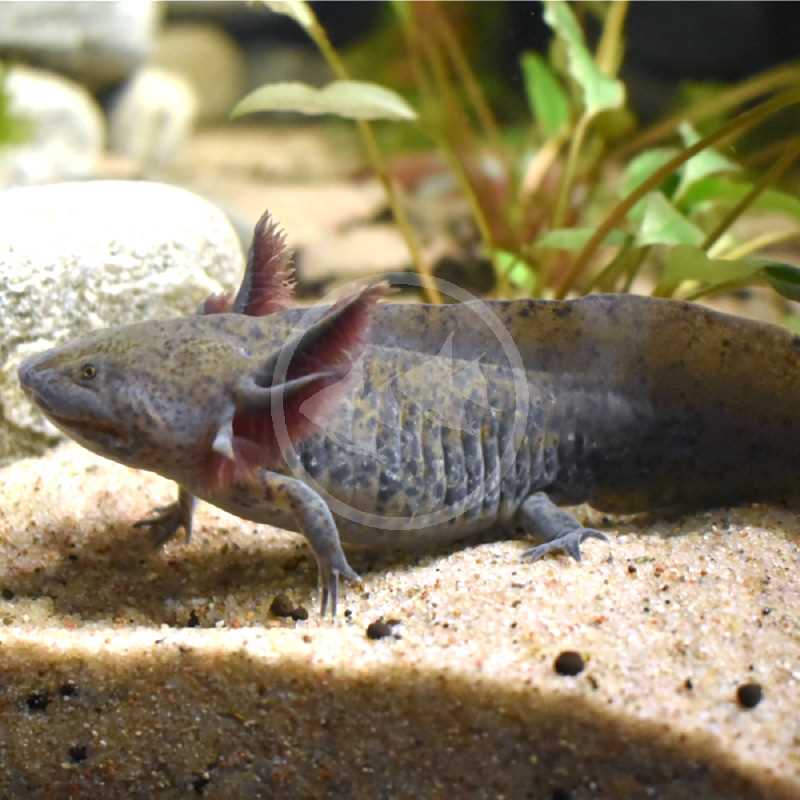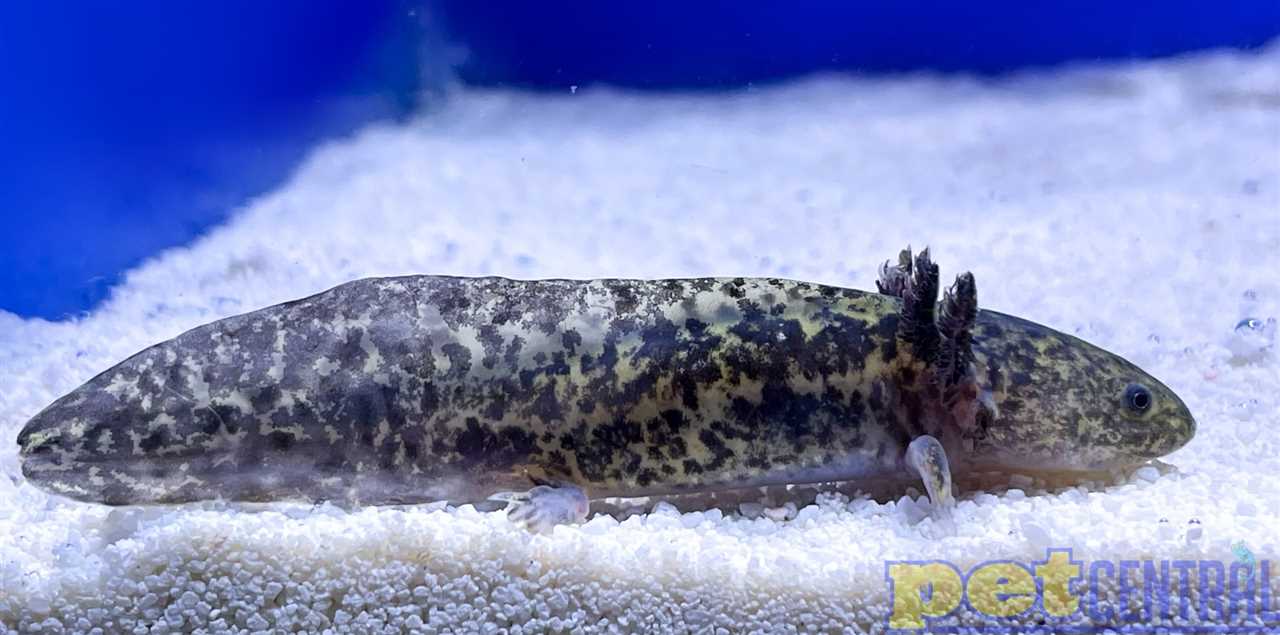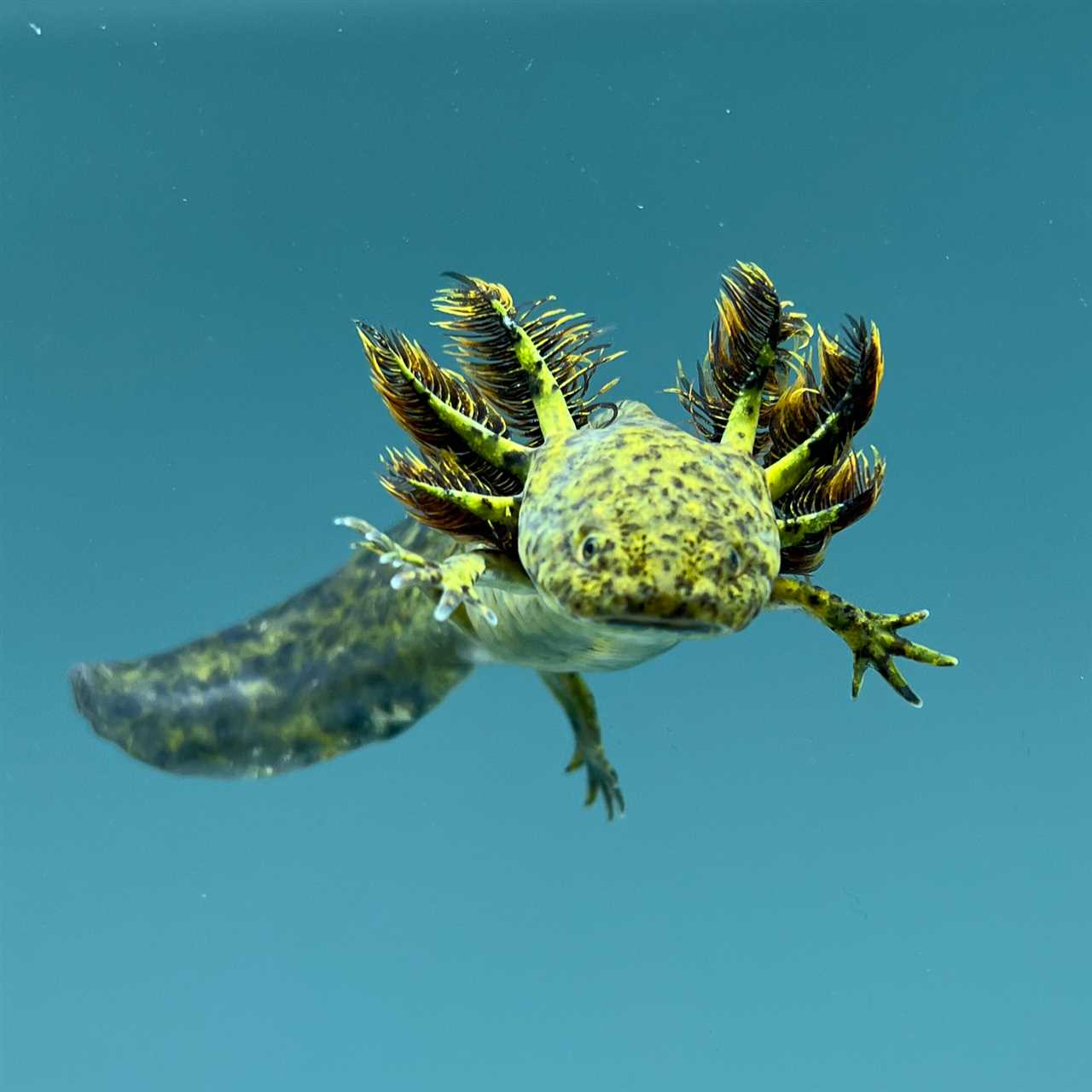
The Axolotl Wild Type is a fascinating type of axolotl, a species of salamander that is native to Mexico. It is known for its unique appearance and extraordinary ability to regenerate its own body parts. The wild type axolotl is the most natural and unchanged form of this species. With its striking look and incredible regenerative powers, the axolotl wild type has become a popular pet for amphibian enthusiasts all over the world.
One of the most distinctive features of the axolotl wild type is its external gills, which are long and feathery and give the animal a charming, almost fairy-like appearance. These gills allow the axolotl to breathe underwater, as it is a fully aquatic creature. Unlike other amphibians, the axolotl does not undergo metamorphosis and remains in its larval form throughout its entire life. This unique characteristic sets the axolotl apart from other salamanders and makes it a truly fascinating creature.
In addition to its striking appearance, the axolotl wild type is also known for its remarkable ability to regenerate lost or damaged body parts. Unlike humans, the axolotl can regenerate not only its limbs, but also its spinal cord, heart, and even parts of its brain. This incredible regenerative capacity makes the axolotl a valuable model organism for scientists studying tissue regeneration and the potential for regenerative medicine.
Appearance and Characteristics
The wild axolotl has a slender body that can reach up to 9-12 inches in length. It features distinct limbs with delicate digits, which allow it to maneuver gracefully through the water. The skin of the axolotl is smooth and is usually grayish-brown in color, although it can also be found in shades of black and albino white.
One of the most remarkable characteristics of the wild axolotl is its ability to regenerate lost body parts. Unlike other salamanders, the axolotl can regrow not only its limbs but also its spinal cord, heart, and even parts of its brain. This unique regeneration capability has made it a popular model organism for scientific research, as it can provide valuable insights into human tissue repair and regeneration.
Unique Features
In addition to its regenerative abilities, the wild axolotl possesses other unique features. It has a specialized jaw structure that allows it to swallow prey whole, which includes small invertebrates, fish, and even other axolotls. The axolotl also has a lateral line system, which helps it detect movement and vibrations in the water. This sensory adaptation enables it to navigate its environment more efficiently and locate potential food sources.
The wild axolotl is also known for its neotenic characteristics, meaning it retains its larval features throughout its life. Unlike other amphibians, the axolotl does not undergo metamorphosis and remains in its aquatic larval form. This unique trait is what gives the axolotl its distinctive appearance and sets it apart from other salamanders.
Axolotl Habitat and Distribution
Due to their specific habitat requirements, Axolotls are strictly aquatic creatures. They are neotenic, meaning they retain their gills and aquatic features throughout their entire lives. Unlike other salamander species, they do not undergo metamorphosis and transition to a terrestrial lifestyle.
Axolotls prefer slow-moving and shallow waters with dense vegetation, such as reeds and water lilies. They rely on these plants for shelter and reproduction.
Conservation efforts are being made to protect their habitat and promote captive breeding programs. It is crucial to preserve the unique ecosystem of Xochimilco and ensure the survival of this remarkable species.
Life Cycle and Reproduction
At around 6 to 12 months old, Axolotls start developing their reproductive organs. Unlike other salamander species, they do not undergo metamorphosis and stay in their aquatic larval form throughout their lives. This makes them an interesting subject for research and a popular choice as pets.
In sexual reproduction, mating involves a courtship ritual where male Axolotls deposit spermatophores on the ground. They then guide the female over the spermatophores, where she collects them with her cloaca for internal fertilization. The female Axolotl can lay hundreds of eggs, which are usually attached to aquatic plants or kept in a secure place.
After a period of time, the eggs hatch into larvae, which resemble miniature versions of the adults. The larvae have gills for breathing underwater and a finned tail for swimming. They go through a series of growth stages, shedding their skin periodically and growing larger over time.
In asexual reproduction, Axolotls are capable of regenerating their entire bodies from a small piece or fragment. This incredible ability allows them to reproduce even if they are the only individual in their environment. The process begins with the formation of a blastemal mass, which eventually develops into a new Axolotl.
The life cycle of Axolotls is relatively long, with individuals living up to 10 to 15 years in the wild. However, with proper care and conditions, they can live even longer in captivity.
Diet and Feeding Habits
The wild axolotl is a fascinating creature with unique dietary needs and feeding habits. As a primarily carnivorous amphibian, it relies on a variety of small aquatic organisms to meet its nutritional requirements.
The axolotl’s diet consists mainly of small invertebrates, such as insects, worms, crustaceans, and mollusks. It also feeds on smaller amphibians, fish, and even its own kind. This cannibalistic behavior is relatively common among axolotls and is influenced by factors such as availability of prey and territorial disputes.
In the wild, axolotls are opportunistic feeders and employ various hunting strategies to catch their prey. They have excellent vision and can detect movement in the water, allowing them to quickly ambush unsuspecting organisms. Their long and slender bodies, along with their delicate, filament-like gills, aid in their swift movements and help them navigate through underwater vegetation in search of food.
Feeding usually takes place during the night, as axolotls are nocturnal creatures. Their keen sense of smell enables them to locate prey even in low-light conditions. Since they are adapted to the murky waters of their natural habitat, axolotls use their strong jaws and sharp teeth to capture and devour their prey. They have the ability to swallow their food whole, or alternatively, tear it into smaller pieces if necessary.
The feeding habits of axolotls are not only essential for their survival but also contribute to their overall health and well-being. A balanced and appropriate diet ensures proper growth, muscle development, and a strong immune system. It is crucial to provide an environment that simulates their natural feeding behavior and meets their nutritional requirements to ensure their long-term health in captivity.
Behavior and Social Structure
During the day, axolotls are mostly inactive and prefer to hide in the vegetation or under rocks. They are primarily nocturnal and become more active during nighttime. They are skilled swimmers and use their long, slender limbs and lateral fin to navigate through the water.
While not highly social animals, axolotls can tolerate the presence of conspecifics in captivity. However, they prefer to have their own space and may become aggressive if they feel threatened or overcrowded.
Overall, the behavior and social structure of wild axolotls are fascinating and unique. Their ability to regenerate and their solitary nature contribute to their survival in the wild.
Adaptations and Survival Skills
The Axolotl Wild Type is a unique type of axolotl that possesses remarkable adaptations and survival skills, enabling it to thrive in its native habitats.
One of the most notable adaptations of the Axolotl Wild Type is its ability to regenerate its limbs, spinal cord, heart, and other organs. Unlike most amphibians, which can only regenerate certain body parts, the Axolotl Wild Type can fully regenerate any lost body part, making it a fascinating subject of study for scientists and researchers.
In addition to its regenerative abilities and neoteny, the Axolotl Wild Type also possesses a highly efficient respiratory system. Its gills, located on either side of its head, allow it to extract oxygen from the water, enabling it to breathe underwater. This adaptation gives the Axolotl Wild Type a competitive advantage over other salamanders that rely on lungs for respiration, as it can remain submerged for extended periods without needing to come up for air.
Overall, the Axolotl Wild Type is a fascinating and highly-adapted species. Its regenerative abilities, neoteny, efficient respiratory system, and camouflage capabilities contribute to its impressive survival skills, making it a truly unique and extraordinary type of axolotl.
Threats and Conservation Status of the Wild Axolotl
One of the major threats to the wild axolotl is the degradation and destruction of its natural habitat, which includes freshwater lakes and canals in Mexico. The expansion of urban areas, agricultural practices, and infrastructure development have led to the loss of these habitats, making it increasingly difficult for the axolotls to find suitable places to live and reproduce.
Pollution is another significant threat to the wild axolotl population. The release of pollutants, such as untreated sewage, agricultural runoff, and chemicals into the water bodies, has resulted in poor water quality and the destruction of the axolotls’ food sources. Additionally, the introduction of non-native species, such as fish and crayfish, to their habitats has caused competition for resources and predation, further endangering the axolotls.
Efforts are being made to conserve the wild axolotl population and prevent their extinction. Several conservation organizations are working to protect the remaining habitats, establish breeding programs, and raise awareness about the importance of preserving this species. Captive breeding initiatives, both in Mexico and internationally, aim to supplement the wild population and ensure the survival of the axolotl in captivity.
Axolotl in Popular Culture

One notable example of the Axolotl’s presence in popular culture is its depiction in art and literature. The Axolotl has been a subject of paintings, illustrations, and sculptures, showcasing its distinct features and captivating allure. Its striking look, with its feathery gills, wide smile-like mouth, and ability to regenerate body parts, has made it a beloved creature for artists to portray.
The Axolotl has also made appearances in various forms of media, including movies, television shows, and video games. It has been featured in documentaries, highlighting its unique abilities and serving as an educational tool for learning about amphibians and biological diversity. In video games, the Axolotl has been included as a character, often portrayed as a cute and friendly creature that players can interact with.
Additionally, the Axolotl has gained attention in the fashion industry, with its distinct appearance inspiring designers to incorporate its unique features into their creations. From clothing prints to accessories, the Axolotl has become a design element that adds a touch of whimsy and intrigue to various fashion items.
Axolotl as a Pet

If you are a fan of unique and exotic pets, then the axolotl is definitely a creature you should consider keeping. Known for its wild appearance and fascinating characteristics, the axolotl has become increasingly popular in the pet trade.
One of the main reasons why people choose to keep axolotls as pets is their unique and captivating appearance. With their fringed gills, beady eyes, and permanent smile, these salamanders are often described as “cute” or “alien-like”. They come in a variety of colors, including wild type, which features a dark blueish-gray body with gold speckles.
Another advantage of owning an axolotl as a pet is their relatively low maintenance requirements. Unlike many other exotic pets, axolotls do not need a large enclosure or complex setup. A single axolotl can be comfortably housed in a 10-gallon aquarium with a sandy or fine gravel substrate, some hiding places like caves or PVC pipes, and a gentle water filtration system.
Axolotls are generally peaceful and can be kept alone or with compatible tank mates, such as other axolotls or small fish species. However, it is essential to research and understand the specific needs of each species to avoid any potential conflicts or health issues.
One interesting feature of axolotls is their regenerative abilities. They can regenerate lost limbs, tails, and even parts of their organs. This remarkable ability makes them even more appealing to pet owners and also provides unique opportunities for scientific research.
Before deciding to keep an axolotl as a pet, it is essential to ensure that you have the necessary knowledge and resources to provide them with proper care. Like any pet, they require regular attention, clean water, and a suitable environment. It is also important to be aware of the legalities and regulations regarding the ownership of axolotls in your area.
Axolotl as a Pet
Setting up the Tank
The first step in keeping an axolotl as a pet is to set up an appropriate tank. Axolotls require a tank that is at least 20 gallons in size to provide them with enough space to swim and explore. The tank should be filled with cool, clean water, as axolotls are sensitive to warmer temperatures. It is also important to provide hiding spots and plants in the tank to mimic their natural habitat.
Water Conditions
Axolotls are amphibians and spend their entire lives in water. Therefore, it is crucial to maintain the proper water conditions to ensure their health and well-being. The water temperature should be kept between 60-68°F (15-20°C). Axolotls require clean, filtered water, and regular water changes are necessary to maintain good water quality. The pH level of the water should be around 7.5, and the ammonia and nitrite levels should be kept at zero.
Feeding and Diet
Handling and Care
Axolotls are delicate creatures, and excessive handling can cause stress and harm to them. Therefore, it is best to limit handling to essential situations such as tank cleanings or health checks. When handling an axolotl, wet your hands first to avoid removing their protective slime coat, and always support their body to prevent injury.
Compatibility with Other Fish
Conclusion

I’m Lena Adams—a product of an unconventional upbringing in the African wilderness. My father, a daring explorer of African wildlife, sparked my fascination with reptiles, a passion that intertwined with the tragic loss of my mother during an expedition, leaving an indelible mark on my life. Driven to understand the creatures that captivated my parents, I embarked on my journey, sharing insights about reptiles, frogs, and lizards on my website. Through my explorations and conservation efforts, I honour my family’s legacy while seeking connections—to the creatures, nature, and the mother whose presence I yearn to understand.
